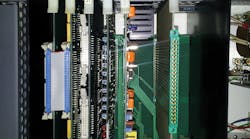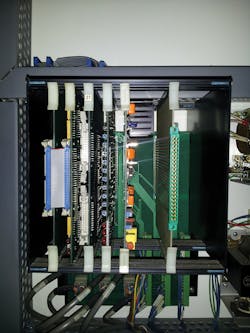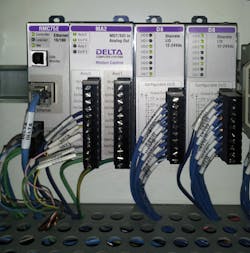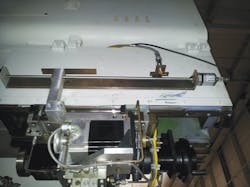The case for retrofitting with advanced motion controllers
In tough economic times, tight capital budgets often force companies to delay purchases of new equipment. Yet they face the ongoing need to increase productivity. Fortunately, upgrading the motion systems on existing machines can bring many of the benefits of new equipment at a fraction of the cost.
Much of the savings depends on the application. For example, if the controls represents 10 to 20% of the machine value, and replacing just them can give new-machine performance, the machine owner saves 80% compared to the cost of a new purchase. And if new controls push productivity beyond previous levels, the upgrade lets users avoid purchasing a more-capable machine.
Benefits from upgrading a machine’s motion system include:
- Replacing obsolete or hard-to-maintain proprietary control systems reduces downtime and maintenance and servicing costs.
- More-powerful and flexible controllers reduce the time an axis needs to move and stabilize at a new position; and they support synchronization and gearing of multiple axes. This can increase throughput.
- A new controller and updated sensors offer greater precision and advanced capabilities such as pressure control, improving product quality.
- Supplementing a new controller with a state-of-the-art human-machine interface (HMI) can reduce the time required to set up a machine when production processes change. Using stored programs, complete motion sequences can be quickly downloaded to reconfigure operations.
- Smoother motion means less shock and vibration, which can reduce repair costs.
- Finally, a subtle factor affecting the new-versus-retrofit decision is the time needed to get a machine up and running. It may be quicker to retrofit using off-the-shelf parts compared to typical lead times with new machines.
When to retrofit
When a machine’s productivity falls and support costs begin to rise, consider retrofitting the motion system. Signs of trouble include increased downtime: A machine frequently needs calibration or repairs, and repairs are getting more complex and time consuming. Possibly, the original machine is no longer being made and repair parts are scarce.
The mechanical elements may still be in workable condition, however. And even if the machine’s structure is worn, a new controller with closed-loop controls can often compensate for wear.
What to retrofit
A machine’s age and the company’s budget usually determine what to replace. Typically, the motion controller and/or PLC lie at the heart of a retrofit. Supporting the controls are transducers that track actuator position, pressure, and force; valves that operate motion actuators; and pumps and accumulators that ensure adequate flow capacity.
Experts recommend replacing rotary encoders and position transducers if they don’t support the new controller’s resolution requirements, or if their outputs have become noisy or unreliable. Replace position transducers that incorporate resistive contacts with noncontacting ones such as magnetostrictive transducers. For maximum precision and noise immunity, also consider installing sensors with digital outputs, such as probes with SSI (synchronous-serial-interface) connections. A motion system that only handled position control or pressure limiting in the past might benefit from additional transducers that precisely control pressure or force.
In place of old two-position “bang-bang” valves, install proportional valves that improve actuator precision. Additional accumulator capacity may be necessary to smooth out pressure transients and improve system response while lightening the load on the pump. If the overall speed of the system is adequate, then existing cylinders may not need to be replaced.
If the system uses a PLC for supervisory control, it may be retained if support and performance aren’t problems. But users often choose to upgrade to a new version along with the motion system. And if the new motion controller has the performance to take over all time-critical tasks, it might actually permit replacing the PLC with a more basic, less-expensive model.
The developer may consider keeping networked interconnections between modules. More often than not, however, it makes sense to update machine wiring to the latest network standards, such as an Ethernet-based protocol.
Besides retrofitting the control system and electronics, companies can upgrade mechanical components all at once or in steps. Often, a retrofit is a natural time to replace these parts due to wear, anyway, so this may be a maintenance cost, not a capital expense. That being said, if any necessary components are obsolete, a key part is no longer available, or if the machine is scheduled to be replaced in a few years, the economic value of retrofitting versus replacing it is put into question. Therefore, a systems-oriented approach is required to weigh risk versus reward.
The bottom line is that if too many changes are needed to get the requisite performance, then retrofitting becomes less attractive compared to buying a new machine. But assuming a retrofit is the economical choice, here’s a look at some key component considerations.
Case in point: A system integrator’s view of retrofits
One successful system integrator with years of experience is Karl Wind, the chief controls engineer with Kenrie Inc., based in Holland, Mich. He offers some tips on best practices regarding retrofits.
Retrofitting a control system versus buying new. Always consider a controls upgrade to existing machinery before proposing a new machine. If the customer needs to increase productivity beyond what a retrofit can accomplish, a new machine may be necessary. Along with a new machine, upgrading controls on other equipment may yield the best overall results.
What’s involved in a retrofit? After we have the required components, we test and tune them on our own in-house R&D machines. When the system matches the customer’s needs, we schedule a time to install and troubleshoot the new components. For the customer, it’s a painless process and usually involves minimal downtime.
How much to retrofit? When weighing which components to upgrade and which to leave alone, always consider cost versus performance and time trade-offs. We always recommend “worst-case scenario” options, but the customer ultimately decides what to retrofit. We work together to find the most cost-effective plan that works.
Other “dos and don’ts.” Know the application requirements. If a retrofit won’t help productivity, it may be a waste of time and money.
Give the customer realistic expectations and time frames. If they expect a retrofit will increase productivity tenfold and be completed in a week, nobody is going to be happy in the end. It’s critical to work together and communicate.
And don’t sell the customer something they don’t need. Retrofitting can increase the life of equipment, but for a machine scheduled to be replaced in six months, less-costly short-term fixes may keep it productive until then.
Motion controller
The goal of a motion-system retrofit is to select a controller suited to the application while replacing only those components required to hit performance and productivity targets. Specific factors to consider include:
Communications support. The ideal motion controller for retrofit applications supports a wide range of communications interfaces and protocols for connecting to the host system. If upgrading the bus as well, the controller must be compatible with modern buses such as ProfiBus,
ProfiNet, or EtherNet I/P. Alternatively, the new controller may need to plug into legacy systems with an older industrial bus.
Transducer connectivity. For efficient retrofits, the motion controller must directly connect to position-feedback devices. For controlling pressure or force, as well as position, the motion controller must also interface with pressure transducers.
Complementary operation. Controllers that run time-critical motion sequences allow fast, consistent, and precise movements — even with slow supervisory PLCs.
Advanced programming options. Improving machine productivity may require complex motion sequences, so the controller software should be easy to program. The controller should support powerful operations such as simultaneously running multiple PID loops, full parameter sets including feed-forwards, and sophisticated instructions such as higher-order equation interpolation. A motion controller that can be programmed with high-level commands often means a motion project can be completed significantly faster than one using more-basic machine commands. This reduces costs and time to market.
Axis synchronization. Advanced motion controllers can synchronize multiaxis motion systems. Rather than hardwiring a machine to run at a certain speed, letting slave axes follow the motion of master axes means engineers can vary or increase the overall throughput of a machine without risking jams or malfunctions. Faster motion usually equates to higher productivity.
And in addition to enabling simple linear relationships between motion axes, some motion controllers also support sophisticated relationships, such as camming.
Other considerations
In addition to the controller itself, other factors can help speed a retrofit. For example, using a motion-control software simulator from the controller manufacturer lets engineers test and validate the motion system before assembling any hardware. (For instance, Delta Computer Systems’ simulator is built into the controller.)The advantage is that correct programming algorithms can be selected and tried out more quickly. This minimizes costs and delays when actual hardware being upgraded must be pulled offline.
Software should also support tuning and diagnostics. Tuning a motion system for best performance is critical for obtaining the full benefits of a control-system upgrade. So the motion controller should include a suite of automated tuning tools that graphically compare actual and target performance. Tools such as Delta Computer Systems’ Set Up and Tuning Wizards speed up and simplify the process of refining and optimizing closed-loop control parameters.
Finally, when upgrading a motion controller, look beyond the product specs. Make sure the motion-system supplier has expertise with your type of application. Mating new technology with existing systems can be a bit like completing a puzzle, and the controls manufacturer can help by providing detailed on-line help, classroom and web-based training, and experienced 24/7 telephone technical support.
Case study: Old honing machines work like new
Honing machines must be precise and repeatable. They’re used, for example, to machine angled grooves on the surfaces of critical engine components such as cylinder walls, diesel liners, and pinion-gear bores to retain oil during engine operation. The linear stroke of the cutting tool must be controlled within microns to generate the required crosshatch angles.
In one class of honing machines manufactured by Micromatic Textron, Berne, Ind., the cutting head rides on rails and is driven by a hydraulic cylinder. To generate crosshatch grooves, the cutting head traverses, then reverses at a precise point. That requires closed-loop hydraulic motion control.
The original honing machines relied on a custom-designed motion controller for the task. But after more than two decades of use, the machines were showing their age. And service information on the original, proprietary controllers was hard to obtain. Controllers that needed service had to be sent back to Micromatic for repairs. Ultimately, obsolescence made the original controllers too costly to maintain. To overcome this problem, Kenrie is extending the productive life of these old, but still-valuable, machines by retrofitting them with new control systems.
Honing application's motion controllers
To direct the hydraulic motion, Kenrie needed an off-the-shelf controller that’s flexible, precise, and easy to program. They chose the RMC75 from Delta Computer Systems. Unlike general-purpose motion controllers, the RMC75 uses special algorithms for hydraulic motion control that permit precise closed-loop control of cylinder position and speed. The Delta controller also executes sequences of register-based commands for position and velocity.
“Our main goal with the Delta controllers is to make the retrofit process plug and play,” says Karl Wind, Kenrie’s chief controls engineer. “With Delta’s RMCTools software and the controller’s built-in simulator, we can program motion sequences, do initial loop tuning, and verify controller operation. Then, when the machine is ready, we do the wiring and we’re good to go.”
For precise position feedback in the hydraulic cylinder that moves the honing head, Kenrie’s engineers replaced outdated position transducers with Balluff, Florence, Ky., linear magnetostrictive-displacement transducers. The noncontacting, absolute position sensor uses a moving magnet that gives high resolution along with long operating life, and it doesn’t require a homing step to provide accurate measurements.
Most Micromatic honing machines already use proportional valves to drive the hydraulics, so it’s usually not necessary to replace them during a retrofit, notes Wind. Proportional valves enable precise control and smooth operation compared to older two-position on/off valves. The Delta RMC75 has built-in analog control capabilities, letting it send analog signals to directly control the proportional valves.
The Delta controller lets programmers change the PID (proportional, integral, differential) control loop on-the-fly and graph motion change with Delta’s Plot Manager software. Beyond the P, I, and D values, the control loops can also contain feed-forward gains for acceleration, velocity, or other parameters that help the system more quickly reach its target position.
Tuning the motion
The upgraded Micromatic machines need to be tuned individually. Each uses different transducers and valves, and feedback parameters must be scaled for processing by the motion controller. “The setup wizards and parameter settings in Delta’s RMCTools software make this easy,” explains Wind. For example, some valves have dead bands that delay response when a cylinder decelerates and changes direction. RMCTools software lets users tune the system in real time to eliminate these effects, notes Wind.
The family of Micromatic machines relies on a variety of PLCs to perform system-level control and monitoring, and they’re typically outdated and have complex wiring. The upgrade replaces old PLCs with new Rockwell Automation, Milwaukee, Allen-Bradley MicroLogix 1400s, SLC 500s, or CompactLogix PLCs, depending on cost/performance requirements. The small PLC and motion controller communicate over a reliable, high-performance Ethernet link. Kenrie also adds Pro-face, Ann Arbor, Mich., HMI screens. The 10-in. touchscreen displays provide basic operator controls for most systems, but the HMIs have full PC capabilities on larger Micromatic machines that hone connecting rods. Typically, the operator enters stroke and velocity for the honing head. Then the HMI downloads the parameters via register mapping methods into the Delta motion controller or saves them to flash memory for later recall. After the system is programmed, changes required to hone different parts means simply recalling the processing “recipe” from flash memory with the touch of a few on-screen buttons. The motion controller also detects faults and errors that occur during operation for display on the HMI.



